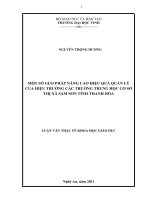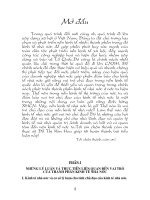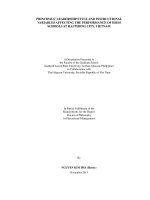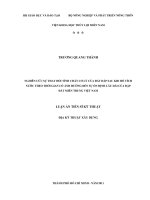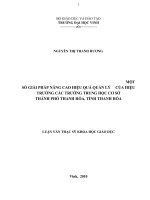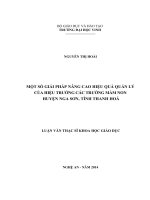Nghiên cứu phong cách quản lý của hiệu trưởng và các yếu tố cấu thành ảnh hưởng đến việc xếp hạng của các trường
Bạn đang xem bản rút gọn của tài liệu. Xem và tải ngay bản đầy đủ của tài liệu tại đây (456.56 KB, 96 trang )
PRINCIPALS’ LEADERSHIP STYLE AND INSTRUCTIONAL
VARIABLES AFFECTING THE PERFORMANCE OF HIGH
SCHOOLS AT HAI PHONG CITY, VIETNAM
A Dissertation Presented to
the Faculty of the Graduate School
Southern Luzon State University, Lucban, Quezon, Philippines
in Collaboration with
Thai Nguyen University, Socialist Republic of Viet Nam
In Partial Fulfillment of the
Requirements for the Degree
Doctor of Philosophy
in Educational Management
By
NGUYEN KIM PHA (Henry)
November 2013
i
APPROVAL SHEET
The Dissertation of
NGUYEN KIM PHA (Henry)
entitled
PRINCIPALS’ LEADERSHIP STYLE AND INSTRUCTIONAL VARIABLES
AFFECTING THE PERFORMANCE OF HIGH SCHOOLS
AT HAI PHONG CITY, VIETNAM
Submitted in Partial Fulfillment of the
Requirements for the Degree
Doctor of Philosophy in Educational Management
In the Graduate School
Southern Luzon State University, Republic of the Philippines
in collaboration with
Thai Nguyen University, Socialist Republic of Vietnam
has been approved by the Committee
_____________________ ______________________
Member Member
______________________ ______________________
______________________
Chairman
DR.TERESITA V. DE LA CRUZ DR. APOLONIA A. ESPINOSA
Adviser Dean, Graduate School
Accepted in partial fulfillment of the requirements for the degree
Doctor of Philosophy in Educational Management
WALBERTO MACARANAN, Ed. D
Vice President, Academic Affairs
_____________________
ii
Date
ACKNOWLEDGEMENT
The researcher wishes to convey his gratitude to the following persons who
wholeheartedly devoted and helped make this piece of work a reality:
DR. TERESITA V. DE LA CRUZ, her adviser for the guidance,supervision,
suggestions and precious time in enthusiastically reading and checking the
manuscript, providing the researcher useful materials;
DR. CECILIA N. GASCON, President of the Southern Luzon State University in the
Republic of the Philippines, for her incomparable contribution and support to
the development of Doctor of Philosophy in Educational Management
program in Thai Nguyen University;
DR. NGUYEN VAN BINH, Director of the International Training Center, Thai
Nguyen University of Socialist Republic of Vietnam, for his enormous pursuit
to provide Vietnamese people an opportunity to grow through education;
MEMBERS OF THE ORAL EXAMINATION COMMITTEE, for their
comments and suggestions that made this research possible;
HEADMASTERS of high schools at Hai Phong City, for their cooperation in the
conduct of the study;
The Director of Hai Phong City Education and Training Department, and the
Education Specialist, for the support during the conduct of the survey.
Teachers-respondents, for their active involvement and participation for without
their cooperation, the result of this thesis might not be possible;
His family and friends, for the love and support in one way or another; and to all who
have contributed to make this study a success.
NKP
iii
DEDICATION
This research is whole-heartedly dedicated to my family and to all my
relatives, my colleagues and friends, and to all classmates, all headmasters and
teachers of high schools of HaiPhong for giving the researcher the non-stop guidance
and sources of everything.
NKP
iv
TABLE OF CONTENTS
Page
TITLE PAGE………………………………………………………….………… i
APPROVAL SHEET…………………………………………………… ………. ii
ACKNOWLEDGMENT…………………………………… ……………… …. iii
DEDICATION……………………………………………… ……………… …. iv
TABLE OF CONTENTS…………………………………… ……………… v
LIST OF TABLES……………………………………………………………… vii
FIGURE…………………………………………………………………………… viii
ABSTRACT………………………………………………………………… …… ix
CHAPTER
1
INTRODUCTION………………………………
Background of the Study…………………… ………………………
Objectives of the Study….….………………………….………………
Hypothesis………………………………………………………………
Significance of the Study ………………… ………… …………….
Scope and Limitation………………………………… … ………….
Definitions of Terms………………………………….…….… ……
CHAPTER 2
REVIEW OF RELATED LITERATURE AND STUDIES.…… …….
Leadership Styles …….………………………………………….
Authoritative or Autocratic Style …….………………………………
Democratic or Participative Style …….………………………………
Delegative or Laissez Faire Style …….………………………………
Instructional Variables …….………………………………
Self-regulated learners …….………………………………
Teacher Charateristics …….………………………………
Technology and Learning …….………………………………
Classroom Climate …….………………………………
Motivation in Diversity …….………………………………
School Performance …….………………………………
Theoretical Framework
…….………………………………
1
3
5
6
6
7
8
11
11
14
15
18
21
21
23
25
28
29
32
34
v
Research Paradigm…………………………………….………………
CHAPTER 3
RESEARCH METHODOLOGY……………………………………
Research Design.……………………….……………………………
Population and Sampling……………………………………… …
Research Instrumentation………………………….………………….
Data Gathering Procedures………………………………………
Statistical Treatment…………………………….…………………
CHAPTER 4
RESULTS AND DISCUSSION…………………………………….…
Leadership Styles of Principals …………………………………….…
Instructional Variables that Influence High Schools’ Performance
Leadership Style and Instructional Variables ………
Performance of High Schools in HaiPhong City, Viet Nam
Instructional Variables and High Schools’ Performance
Proposed Strategic Action Plan
CHAPTER 5
SUMMARY, CONCLUSIONS AND RECOMMENDATIONS
…
Summary …………………………….……………………………
Findings………………………………………………………………….
Conclusions…………………………………………………….…….…
Recommendations…………………………………………… ……….
35
37
37
37
38
39
39
42
42
48
57
62
63
66
72
72
73
75
77
vi
BIBLIOGRAPHY….…….………………………………………………………
APPENDICES…………………………………………………………… ……
A Communication…………………………………………………………
B Instrument ………………………………………………… ………….
CURRICULUM VITAE……… ………………………………………………
78
81
82
88
vii
LIST OF TABLES
Table
1.1
1.2
1.3
2.1
2.2
2.3
2.4
2.5
3.1
3.2
3.3
4
5.1
5.2
Frequency and Weighted Mean Distribution on Headmasters’
Leadership Styles as to Authoritative Style………………………
Frequency and Weighted Mean Distribution on Headmasters’
Leadership as to Democratic Style………………………………
Frequency and Weighted Mean Distribution on Headmasters’
Leadership as to Delegative Style………………………………
Frequency and Weighted Mean Distribution of Instructional Variables as to
Self-regulated Learners………………………….
Frequency and Weighted Mean Distribution of Instructional Variablesas to
Teacher Characteristics………………………….
Frequency and Weighted Mean Distribution of Instructional Variables as to
Classroom Climate……………………………….
Frequency and Weighted Mean Distribution of Instructional Variables as to
Technology and Learning……………………….
Frequency and Weighted Mean Distribution of Instructional Variables as to
Motivation in Diversity……………………………
Correlation of Authoritative Leadership Style to Instructional
Variables…………………………………………………………….
Correlation of Democratic Leadership Style to Instructional
Variables…………………………………………………………….
Correlation of Delegative Leadership Style to Instructional
Variables…………………………………………………………….
HaiPhong City, Viet Nam High Schools’ Performance
from 2008-2013……………………………………………………
Predictor of High Schools’ Performance as to Instructional Variables in
terms of Motivation in Diversity……………………
Predictor of High Schools’ Performance as to Instructional Variables in
terms of in terms of Classroom Climate……………
Page
43
44
46
48
50
52
53
55
57
58
60
62
64
65
viii
FIGURE
Figure Page
1 Research Paradigm ………………………………………….……. 35
ix
ABSTRACT
Title of Research :PRINCIPALS’ LEADERSHIP STYLES
AND INSTRUCTIONAL VARIABLES
AFFECTING THE PERFORMANCE OF HIGH
SCHOOLS AT HAI PHONG CITY, VIETNAM
Researcher :NGUYEN KIM PHA (Henry)
Degree Conferred :Doctor of Philosophy in Educational Management
Name/ Address :Southern Luzon State University
of Institution Lucban, Quezon
Adviser :DR. TERESITA V. DE LA CRUZ
Year Written : 2013
This study sought to determine the principals’ leadership styles and
instructional variables affecting the performance of high schools and with an end view
of developing a strategic action plan at Hai Phong City, Vietnam, for school year
2012-2013. The descriptive method of research was employed to 896 respondents
drawn from 14 high schools in the city. The instrument used for the types of
leadership styles was adapted from the questionnaire of Clark (2002), and
instructional variables from that of Mentilla (2011). It was found out that the
leadership styles of the respondent principals are authoritative with 3.34 AWM
(sometimes carried out); democratic (3.81, oftentimes carried out); and delegative
(3.52, oftentimes carried out). The instructional variables that may affect high schools’
performance are self-regulated learners with 2.93 AWM (agree); teacher
characteristics (2.74, agree); classroom climate (2.76, agree); technology and learning
(2.35, disagree), and motivation in diversity (2.60, agree). With an average of 66.4,
there are nine high schools above the average and five (5) below average level of
performance where the highest mean is obtained by Ngo Quyen High School with
94.8 and is consistently leading while the least is Phan Dang Luu High School with
36.3. Motivation in diversity can predict school performance up to 1% while the
x
classroom climate by up to 0.5% which indicates negligible correlation. Hence, most
headmasters practice shared decision-making, participative and permissive leadership.
The democratic and the delegative leadership styles are mostly related to some areas
of instructional variables. However, it is still recommended that a balance of the
authoritative, democratic and delegative leadership styles may be constantly practiced
by the headmasters, since each holds benefits to the organizations they serve.
Technology in learning may be improved by the department to further boost the
performance of the high schools in Hai Phong City.
1
Chapter I
INTRODUCTION
Education is counted on as the important aspect of the human life. The ways
how one translates it after receiving into the daily life is dependent largely upon the
way the form of education gets passed on. The topic of educational leadership has
been taught for a number of years in the education management institutions to address
long-standing concern of all educators, students and the entire society. As the
requirement to understand the style which would work best, in combination or alone,
it is imperative to understand all types individually regarding what these types offer
and their methods.
The purpose of utilizing different types of leadership styles in education is
mainly to improve the quality of teaching, that of learning, and to create a unique and
effective combination of both. As the competitiveness in the world of education
increases, implementation of these leadership styles becomes more and more
important. The role of every individual starting from principal, to the teachers, to the
students is important and the ultimate goal remains the enhancement and upkeep of
teaching-learning relationship. The job of every individual in educational leadership,
is to create the necessary conditions for teachers to develop and execute their own
teaching styles and methods, in a manner that is simple and most effective for
students. Also, the development of other aspects of educational framework, such as
association with external groups that facilitate better teaching and learning, the care of
infrastructure and others all come up under the purview of educational leadership.
With the eye for reformation, a great number of educators either have
criticized or supported some of the education management leadership styles, however,
2
which style works and suits best is subjected to a matter of opinion. The educational
leadership styles are basically built on the understanding which contains
characteristics like social interaction and/or physical energy play a part in the method
the education is imparted. The theory of effective leadership is all about adding the
performance of all the education leaders, basically the educators, in order to improve
the achievement of the students. Hence, the effective leadership is very much
important for both the students and the teachers to enhance the performance at highest
level.
As mentioned by Buckner (2006), the type of leadership style is one of the
major factors that determine the performance of school besides others such as school
traditions and policies. This is because a principal might find that deviating from the
traditional leadership style of the school might result in management crisis. None can
deny the fact that there is no single way to inspire and lead in the education field.
Every educator and the schools as well, view all the leadership strategies in different
ways, as in some situations, actions and features seem much more favorable than the
others at different times and levels. In the broad ways, there are differet types of
leadership styles that may be applied in educationl management. To mention few,
most popularly used in the field of education is Lewin’s leadership styles as to
authoritative, democratic, and delegative.Others that are used in versatile combination
or individually are transformational, facilitative and hierarchical.
Meanwhile, performance of schools may not only be attributed to the
schoolheads’ leadership styles but may also be looked into another factor like the
instructional variables. There are studies citing that instructional variables like
classroom climate, teacher characteristics, class structured self-regulated learners, and
3
educational technology could be factors in uplifting the school performance as a
whole (Pierce,2006; Acikgoz, 2005;Liao,2009).
Considering leadership styles and instructional variables as a whole, school
performance can be viewed in a clearer and more precise perspective. Quality school
performance requires competent and well-skilled teachers and administrators in
reconstructing and implementing school plans, policies and rules to strengthen
learning. Based from the above premise, this study was conceived.
Background of the Study
High schools functions are far different from the primary schools since the
former are of relatively high independence. Hence, the possible role of management is
extremely important for principals. School heads as leaders if they fulfill the
necessary strength and run the rail track will definitely reach the target in all aspect of
management professional groups.
However, the quality of teaching staff of a school being still inadequate in
terms of number of teachers, structural mismatches, professional capacity of teachers
not timely responding to the increasing demands of the innovation education
today.Before these shortcomings, the development of the teaching staff of the school
have become urgent tasks that need solutions to fix right away to improve the quality
of teaching and learning to meet training needs of human resources for quality local
country.
Active professional groups in Hai Phong High School have still many
problems that needed to be overcome. For the objective reasons emerge still human
mechanisms and programs, the content is not compatible with each other. On the other
hand, the supply conditions for the human needs and activities have too many
contradictions especially the management team for many years has not been
4
mentioned in the argument, the head professional, the direct leadership of base unit in
the school management training; should direct process practical observation.
On the other hand, classroom climate is very important for high school
students to develop their behavior to people who live around. Twenty-first century is a
century for technology, there are a lot of software to manage to work better so each
person has to take the chance to use technology. If not, then one is out of date.
Moreover, students in high school are improving their behavior, so they must be
encouraged to study better. Discussing the reality of student learning high school,
besides the delight of students, passion for learning, there is also a small part of pupils
feel school bored, caused by loss of interest in learning. Lazy pupils increase which
affect learning outcomes of students in particular and in the quality of high school
education in general, especially that high school agers are preparing for biggest
turning point in college, and the loss of interest in learning to make them lose
motivation. The lazy pupils say that many of them upon seeing the books feel
headaches, dizziness, snapped just want to push them aside for free.
The management of the center and the role of principals is huge. If the
principal does not renew, it is difficult to reform school. Practice has proven that the
most influential in the industry management system to learn results of school's
students. The style of principal work affects operating environment of the school. In
addition to capability to design programs and plans, principals must have thought of
suggestive referendum and decide the goals to remedy the inconsistent management
solutions, lack of scientific institutions from the direct innovation programs, teaching
and learning methods, and the use of information technology to manage and improve
teachers. This prompted the researcher to conduct the study on the principals’
5
leadership style and the instructional variables affecting the performance of high
schools at Hai Phong City in Vietnam.
Objectives of the Study
This study determined the principals’ leadership styles and instructional
variables affecting the performance of high schools and with an endview of
developing a strategic action plan at Hai Phong City, Vietnam, for school year 2012-
2013.
Specifically, it sought to attain the following objectives:
1. Determine the leadership styles of the respondent principals as to;
1.1 Authoritative
1.2 Democratic
1.3 Delegative
2. Find out the instructional variables that may affect the performance of high schools
in terms of:
2.1. Self-regulated learners,
2.2. Teacher characteristics,
2.3. Classroom climate,
2.4. Technology and learning, and
2.5. Motivation in Diversity.
3. Analyze if there is a significant relationship between the leadership styles of
principals and the instructional variables.
4. Determine the level of performance of the respondent high schools.
5. Find out which of the instructional variables predict school performance.
6. Develop a strategic action plan.
Hypothesis
6
1. There is no significant relationship between the principals’ leadership styles and
the instructional variables in high schools at Hai Phong City.
2. None of the instructional variables predict the performance of high schools at Hai
Phong City.
Significance of the Study
This research would help the school leaders, teachers, students, and future
researchers.
School Leaders.This study would contribute to the school supervision among
school heads in the sense that they would be informed in the new dimension of
modern leadership by knowing and understanding their own leadership styles. They
would understand how the types of leadership may influence to the overall school
performance. The output of this study which is the proposed strategic action plan may
be considered by school heads in their school year planning for further improvement
of their academic programs.
Teachers.They would be benefited in this study since they play an important
role in the delivery of knowledge. Knowing the different leadership styles of their
immediate heads would give them time to adjust to the different situations in the
school. They would be informed as well on various variables that may affect students’
performance whereby they could plan and innovate interesting classroom activities.
The developed strategic action plan will guide them to know what would be their role
to raise the school performance.
Students. Since the heart of the teaching-learning process are the students,
they would be benefited for they are the main concern of both the school heads and
the teachers. A school with conducive environment, flexible school heads with the
7
good leadership styles, and committed teachers would create better school
performance as a whole.
Future Researchers.This study would give future references to those
researchers who wish to have a similar study and likewise develop a strategic plan.
Thus, knowledge on the leadership styles and important instructional variables could
serve for their future reading resources.
Scope and Limitations
This study was conducted in Hai Phong City focusing only in the types of
leadership styles and the instructional variables that may affect the school
performance.There were 14 high schools involved in this study with a total of 896
respondents comprising of headmasters and teachers.
The types of leadership styles used in this study were based from Lewin’s
authoritative, democratic and delegative styles. On the other hand, instructional
variables identified in this study were self-regulated learners, teacher characteristic,
technology and learning, motivation in diversity, and classroom climate.A strategic
action plan was developed based from the results of the study.
To gather the data, the researcher used the validated questionnaire of Mentilla
(2011) in determining the instructional variables that may affect the school
performance. It was composed of 50 statements that describe each variable. The
instrument to measure the leadership styles of respondents was based from leadership
styles survey instrument used by Clark (2010). It was composed of 30 statements
modified to suit to Vietnam High School setting.
The time frame of this study was from October 2012 to August 2013.
Definiton of Terms
8
For clarity and better understanding of this study, the following terms are
defined both conceptually and operationally:
Authoritative Style is a type of leadership where the leader makes decisions
without consulting others (Lewin, 1939). The same definition was used in this study.
Classroom climate is the combination of variables within a classroom that
work together to promote learning in comfortable environment
(www.ehow.com/info_definition-classroom-climate.html). In the study, it refers to a
place where students are secured to learn to develop their self-efficacy, competence,
self-determination and task comprehension.
Delegative (or laissez-fair) is another leadership style used in this study in
which leaders offer little or no guidance to group members and leave decision-making
up to the group members (Lewin, 1939).
Democractive (or Participative) Style refers to a type of leadership used in
this study by which leaders offer guidance to group members, but they also participate
in the group and allow input from other group members (Lewin, 1939).
Instructional variables are one of the main variables in this study which
comprise the self-regulated learners, classroom climate, motivation in diversity,
teacher characteristics, and technology and learning.
Leadership styles are likewise a main variable in the study referring to the
manner and approach of providing direction, implementing plans, and motivating
people (Lewin, 1939; Clark, 2010).
Motivation in diversity in this study, it refers to the encouragement for the
students to participate in the classroom activities, and interact with their peers despite
their individual differences.
9
Principal refers to the school headmaster who administers and supervises the
whole academic programs in high schools.
Performance of students refers to the average grades of the students in all
their subjets in a school semester.
Self-regulated learning (SRL) emphasizes the autonomy and control by the
individual who monitors, directs, and regulates actions toward goals of the
information acquisition, expanding expertise, and self-improvement (Paris & Paris
2001). In this study, it refers to students who can learn by themselves and work
without closed supervision by the teacher.
Strategic Action Plan refers to sequence of steps that must be taken, or
activities that must be performed well for the strategy to succeed. An action plan has
three major elements, viz: 1) specific tasks: what will be done; 2) time horizon: when
will it be done; 3) resource allocation: what specific funds are available for specific
activities ( It is the
output developed based on the results of the study.
Teacher characteristics form part of instructional variables whichrefer to the
teacher’s personal and professional qualities.Personal qualities deal with their
attitudes and behavioral attributes while professional qualities deal with how they
deliver their teaching.
Technology and learning refers to how technology is used by the teacher in
teaching-learning process, and how students interact with this mode of teaching
delivery.
10
Chapter II
REVIEW OF LITERATURE AND STUDIES
This chapter presents relevant readings and related literature which bear
significance and similarities to this study. This also includes the conceptual/theoretical
framework and paradigm that could help the readers fully understand the context of
the study.
Leadership Styles
Managers and leaders in any organization are expected to influence the actions
of their employees through the several channels. Some of these include
communicating with staff members, stimulating subordinates to work hard and
ensuring that all the resources within the company are allocated well. Numerous
researchers felt a need to come up with theories that govern successful leadership.
One of these is known as the contingency theory.
Fielder (2004) came up with this approach to leadership after realizing that
leaders can function well if they changed their styles to suit the situation at hand. This
is where the name contingency originates. Fielder conducted several studies of
effective and ineffective leaders. Thereafter he concluded that the most successful
approach would be to match organizational settings with leadership styles. These two
parameters form the basis of contingency theory of leadership.
According to him, leadership style may be defned as the way leaders and
employees interact with one another. One cannot claim that a manager’s leadership
style changes from time to time. The leader's ability to lead is contingent upon
various situational factors, including the leader's preferred style, capabilities and
behaviors of followers and various situational factors.
11
He further stated that contingency theories are a class of behavioral theory that
contend that there is no one best way of leading and that is effective in some
situations which may not be successful in others. An effect of this is that leaders who
are very effective at one place and time may become unsuccessful either when
transplanted to another situation or when the factors around them change. This helps
to explain how some leaders who seem for a while to have the 'Midas touch' suddenly
appear to go off the boil and make very unsuccessful decisions.
According to Gardner (n.d.), in On Leadership, "Leadership is the process of
persuasion or example by which an individual (or leadership team) induces a group to
pursue objectives held by the leader or shared by the leader and his or her followers."
If we accept that definition, then leadership style is the way in which that process is
carried out (
Leaders' styles encompass how they relate to others within and outside the
organization, how they view themselves and their position, and - to a very large extent
- whether or not they are successful as leaders. A task needs to be accomplished, how
does a particular leader set out to get it done. Much of the material in this section
looks at individual leaders, but leadership can be invested in team, or in several teams,
or in different people at different times. Many - perhaps most - organizations have
several levels of leadership, and thus many leaders. Regardless of the actual form of
leadership, however, leadership style is an issue. Whether you're the leader of a large
organization or a member of a small group that practices collective leadership, the
way that leadership plays out will have a great deal to do with the effectiveness and
influence of your work.The style of an organization's leadership is reflected in both
the nature of that organization and its relationships with the community. If a leader is
suspicious and jealous of his power, others in the organization are likely to behave
12
similarly, in dealing with both colleagues and the community. If a leader is
collaborative and open, she is likely to encourage the similar attitudes among staff
members, and work collaboratively with other groups
(
Meanwhile, Antoine (n.d.) cited that the managerial leadership has influenced
organizational activities in many ways. These influences include motivating
subordinates, budgeting scarce resources, and serving as a source of communication.
Over the years, researchers have emphasized influences of leadership on the activities
of the subordinates. These emphases by the researchers led to theories about
leadership. The first and perhaps the most popular, situational theory to be advanced
was the Contingency Theory of Leadership Effectiveness developed by Fred E. Fiedler
(Bedeian&Glueck, 2000). This theory explains that group performance is a result of
interaction of two factors. These factors are known as the leadership styles.
Contingency theories state that no leadership style is suited for all situations. Its
success depends on situational factors, including the leadership style and the abilities
and behavior of the followers.
According to Murray (2013), leadership is less about one’s needs, and more
about the needs of people and the leader’s organization. The leadership styles are not
something to be tried on like so many suits, to see which fits. Rather, they should be
adapted to the particular demands of the situation, the particular requirements of the
people involved and the particular challenges facing the organization. He further
stated that in developing one’s leadership style, the idea of Drucker (2007) may be
considered based from his creation of “modern study of management.” Drucker
divided manager’s job into five basic tasks: 1) sets objectives,2) organizes,3)
motivates and communicates,4) measures, and 5) develops people. All leadership
13
styles can become part of the leader's repertoire. In many, or perhaps most
organizations, more than one of these conceptions may define leadership. Each
implies particular ways of leading, and leaders may use a number of different
methods.
Leadership is the process of motivating a group of people to act towards
accomplishing a common task. There are number of recognized versions, or styles, of
leadership, some of which have been shown to be more effective than others. In 1939,
a group of researchers led by the German-American psychologist Kurt Lewin
identified three major leadership styles: authoritarian; participative or democratic;
and delegative or laissez faire. Good leaders may well adopt some element of all of
the styles of leadership.
Authoritative or Autocratic Style
Lewin (1939) as one of the main proponent of the leadership style describes
autocratic leaders who seek to have the most authority in decision-making and
provide the rest of the group with clear expectations regarding what needs to be done
and how it should be done. They try to make as many decisions as possible and
consultation is minimal. This leadership style is effective on short-term projects or in
environments where employees are poorly motivated or need to perform low-skilled
tasks.
This leadership style offers some benefits to managers who use it. It reduces
their stress levels as they know they have full control and it also improves the
working speed of poorly motivated employees, who know they are being watched by
a leader. One of the main disadvantages of this style is that by making all the
decisions, the leader doesn't give the other members of the group the opportunity to
start their leadership development. By taking all responsibility, the leader works at full
14
capacity, which can lead to health problems and poor working relationships with
colleagues.
Autocratic leadership allows quick decision-making, and eliminates arguments
over how and why things get done. At the same time, however, it may reduce the
likelihood of getting a range of different ideas from different people, and can treat
people badly, or as if they don't matter. If, as is often true, the leader is concerned with
his own power and status, he will be looking over his shoulder, and moving to squelch
any opposition to him or his ideas and decisions. They are leaders who insist on doing
it all themselves. They have all the power, make all the decisions, and don't often tell
anyone else about what they're doing. If you work for an autocratic leader, your job is
usually to do what you are told. An autocratic leader often maintains his authority by
force, intimidation, threats, reward and punishment, or position. Although he
may/may not have a clear vision, and may/may not be steering the organization in the
right direction, he is not concerned with whether anyone else agrees with what he is
doing or not (
Democratic or Participative Style
A democratic leader understands that there is no organization without its
people. He looks at his and others' positions in terms of responsibilities rather than
status, and often consults in decision-making. While he solicits, values, and takes into
account others' opinions, however, he sees the ultimate responsibility for decision-
making as his own. He accepts that authority also means buck stops with him.
Although he sees organization as a cooperative venture, he knows that he ultimately
has to face the consequences of his decisions
alone(



